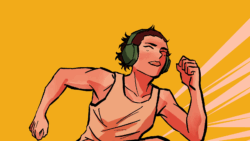Although I call myself the greatest Jeremy Lin fan in the world, I regret to say that I did not take the hour and a half trip to see his documentary, Linsanity, when it debuted in October 4, 2013. My pre-ordered copy of the movie, however, arrived during the weekend so I finally had the chance to watch the whole story of one of the best stories in modern sports.
Linsanity chronicles Lin’s journey from the beginning of his AAU days until the height of Linsanity in New York. When looking at his story from the beginning, I truly understood the unlikeliness of his rise to fame. Not heavily recruited out of middle school, Lin eventually played for Palo Alto High School, a Division II school where he would establish himself as a dominant scorer and lead his team to an undefeated record until he injured his ankle in a simple pick up game at his local YMCA.
Although Lin would carry his team to the California Division II State Title in his senior year when they beat the number 11 ranked team Mater Dei, this rollercoaster of failure and successes would become a fixture of his basketball career. Despite averaging 15 points, 4.6 rebounds, 4.6 assists, and 4 steals per game, colleges did not heavily recruit Lin. Stanford and UCLA offered to let him join as a walk-on, but he wanted the opportunity to start. So a “small school” called Harvard decided to give Lin a chance to start.
With a 4.2 GPA and a 2360 SAT score, Lin met the academic standards of Harvard even though he did not even answer one question on his math and Chinese placement exams (I could have at least answered one). Lin steadily improved during his time at Harvard but the pinnacle of that improvement came when he lead the Crimson to a 21-8 season and was a top eleven candidate for the Bob Cousy award, a award for the best collegiate point guards. Georgetown even saw a preview of Linsanity when Harvard came to the Verizon Center to play the Hoyas. We warm heartedly welcomed him with several racial slurs by fans, beginning the tradition Georgetown has of sportsmanship with players of Chinese heritage.
Even though Lin had a strong college career, he went undrafted and the most exciting part of his summer was matching the number one pick at the time, John Wall, point for point during the NBA summer league. Fortunately for Lin, one of the new owners of the Golden State Warriors at the time, Joe Lacob, knew Lin because he played against his son, Kirk, during high school. The Warriors then signed Lin to a one year deal, and Lin’s NBA career began.
Unfortunately, so did the exploitation of Lin’s heritage.
Whenever I went to see Lin play the Wizards, the Verizon Center just happened to hold Asian Heritage Night as well. In 2013, the Wizards’ dancers even had a performance to a popular Korean music group. When I went earlier this January, the same Chinese dance troupe that performed at halftime when Lin visited last year came. I always believed this was just a coincidence. Chinese new year was typically around the time the Rockets come to play the Wizards, so the timing sort of worked.
In 2010, during Lin’s rookie year, the Warriors decided to hold Asian Heritage Night on October 29, 2010, a date no where near any widely known Asian holiday or May, Asian Pacific heritage month. While his minutes declined and the vague Asian references grew, Lin began to think he was more of a marketing gimmick instead of an NBA player. Warriors Stephen Curry and Monta Ellis were also taking up the majority of the minutes at the guard spot, so Lin did not have an opportunity to develop (Ironically, this was also when Ellis was taking up most of the touches).
Then the Warriors sent Lin to the D-League.
His agent told him that his only goal in the D-League was to fill up the stat sheet every night. Lin’s time in the D-League was probably the darkest time of his career. The frustration was visible, and he began to lose his faith in basketball. Lin’s pastor, Stephen Chen, remembers that Lin would come into church sometime and tell Chen he was thinking about quitting basketball. Finally, the Warriors cut Lin, and ironically, the Rockets picked him up.
GM Whiz Kid Daryl Morey said in an interview that the Rockets had an eye on Jeremy for a while even though the Rockets already had Kyle Lowry, Goran Dragić and Jonny Flynn at the point guard spot. The Rockets then waived Lin on December 24, 2011. Then on December 27, 2011, the Knicks would claim Lin.
A few injuries later, Lin was the man in New York and redefining the stereotype of the Asian man.
Now Lin is back with the Rockets, playing as a sixth man after starting for the Rockets during the 2012-13 season. Even though Linsanity may be over, Lin’s incredible story of rising from being an undrafted player to one of the best driving guards in the NBA is something that will stay in the history books.
The documentary truly captures the turmoil Lin went through during his darkest moments, contrasting the success he enjoys today. Colleges barely even looked at Lin and most NBA teams would only exploit Lin’s Asian heritage, but he continued to follow his dreams and went on an incredible run. He stayed humble and always credited God for his success, yet he never espoused his Christianity in a way that seemed pushy, unlike another sports phenom who decided to bless New York with his presence.
I highly recommend everyone watch this documentary at least once. The media inundated us with Jeremy Lin since his time in New York, but this is the first time we truly see him at his most vulnerable, allowing us to appreciate his journey even more. These days, most of us compare Lin when he was dropping 37 on Kobe in MSG, but the documentary gives us a wider perspective and makes us realize that even though he is averaging less and playing a reduced role in Houston, that’s better than being a marketing tool for the Warriors





